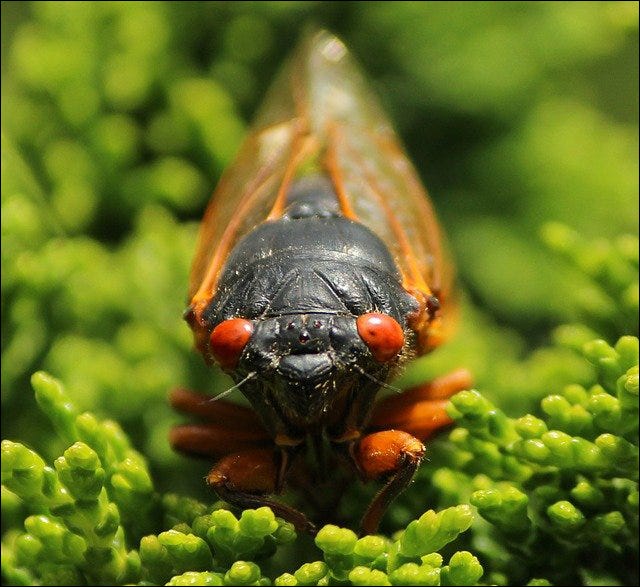This issue is about an underground network of Hemipteran sleeper cells, mind control, psilocybin- and amphetamine-fueled hypersex, and literal ass-eating. Along the way, you’ll learn a thing or two about biology and behavior. We’ll end with some philosophical musing about aliens. Do not hesitate to take the ticket for this ride.
In today’s newsletter you will learn:
About the cicadas emerging in the U.S. this year
Their fungal drug dealers
And how the brain-haves are manipulated by the brain-have-nots
The Rise of Brood X
At this moment, billions of squishy, juvenile cicadas are bubbling forth from the sultry forest floors of the Eastern United States. Their red, wide-set compound eyes have not absorbed a photon of light since 2004. Like so many of us groggily emerging from our pandemic hideyholes, these hemipteran kings and queens are ready to PARTY. 💃🕺

For the past seventeen years, Brood X, the largest brood of cicadas belonging to the genus Magicicada (literally, magic cicada), have been slogging through their development stages in earthly chambers six feet underground. Feeding on the liquid inside tree roots, pooping it all over themselves and their chamber, and shedding exoskeleton as they grow through their five nymph stages, this massive cicada network has been waiting for 2021. This is the year that they are biologically programmed to emerge, make a shit ton of noise, mate, and die.

I could bore you with the details of the Magicicada life cycle. Their massive pilgrimage up trees to shed their final exoskeleton, the intriguing acoustical design of the male cicada anatomy, the nuance of cicada flirting, mating, and dying, but others have covered it. We both know why you’ve read this far. You want to know what’s up with that psilocybin & amphetamine sex stuff. 🧐
Psilocybin and amphetamine sex stuff
Around May of their 17th year, the rising summer temperature signals the Magicicada nymphs to initiate the adult stage of their life. As excavate themselves from the soil, some of the nymphs come into contact with the spores of a fungus belonging to the genus Massospora. As far as anyone can tell, the infected cicadas don’t ever find out what hit them. They move through the next few and final weeks of their lives fairly normal, with a few behavioral modifications (i.e. mind control) here and there.
Meanwhile, Massospora are ramping up the cicada-borne stages of their life cycle. Upon infection, Massospora moves into the abdomen of the cicada and start producing two things; conidia and cathinone, i.e. spores and speed. As the growing Massospora tumor chews through the connective tissue in the cicada abdomen, segments of exoskeleton are sloughed off, leaving behind a chalky, light yellow chunk of fungus. The consumption of cicada arse is complete. 🐴❓
Massospora grows and thrives, while its cicada host begins to exhibit abnormal behaviors. The most noticeable is hypersexual behavior. Both males and females will display exaggerated sexual displays which are normally only seen in cicadas who have not yet mated by the end of the season. Even more mysterious, males will exhibit a female wing-clicking behavior to attract other males, who they will then try to copulate with (Lovett et al. 2020). As the infected sex fiends fly around and aggressively yet non-discriminatorily attempt to mate with other cicadas, conidia spores are launched through the air and the infection moves swiftly throughout the high density population. Eventually the strung out, infected cicadas fall to the ground, unmated, ass-less, dead, and chock-full-o’-spores to infect the next brood. ☕️

The hypersexual mind control strategy that Massospora is using here is called Active Host Transmission (AHT). AHT is different than other fungal mind control strategies because the host is kept alive and their behavior is altered in ways that increase fungal spore transmission. AHT requires the fungus not only to manipulate behavior, but to avoid detection while doing it. Massospora is clearly quite good at AHT, as it cleaves off an entire body segment without being noticed (Lovett et al 2020). 🥷
What about the speed and psilocybin? Scientists recently discovered two species of Massospora that produce psychoactive alkaloids (Boyce et al. 2019). The species that infects the Magicicada on the east coast produces cathinone (i.e. amphetamine), while a species that infects annual cicadas in the Western U.S. produce psilocybin. Interestingly, the biochemical pathway that Massospora uses to synthesize these compounds is different than the pathway other organisms use. An extensive genomic search only turned up a portion of the typical metabolic genes involved in the alkaloids biosynthesis, suggesting there is an undescribed biosynthesis pathway lurking in this frisky fungus (Boyce et al. 2019).
It is still unknown why Massospora produces these compounds, but everyone’s guess is that they might contribute to the hypersexual spore-spreading behaviors of infected cicadas. AHT requires some pretty complex centrall nervous system control, and it is certainly plausible that psychoactive compounds play a role in that. It is well established that cathinone can alter insect behavior, and it is produced by Massospora at high enough levels to do it. It is less clear on how psilocybin might affect insect behavior. Although serotonin is a key neurotransmitter in insect behavior, more studies are needed to determine how a 5HT2A receptor agonist such as psilocybin can alter the insect mind.
Fungi Mind Control and You
We’re all thinking it. Are my Golden Teachers just using me to spread their spores? Are my deep inner journeys just elaborate ruses implanted by clever Basidiomycote tricksters? Is my butt looking a little chalky and yellow?
The clearest answer I can give is mostly no but maybe yes. There are some key differences between our relationship with P. cubensis, and Magicicada’s relationship to Massospora. For one, P. cubensis strains do not need humans, nor any animal, to complete its life cycle. They do pretty well in nature on their own, and are actually quite finicky to grow within the human domicile. They also don’t kill us, a trait we tend to like. That being said...the mind-altering effect of psilocybin certainly promotes their propagation. If not by you the consumer, then by someone along the mushroom supply chain you support. There are ideas out there as to why psilocybin genes evolved in so many unrelated fungi species, but we do not have enough evidence to be reasonably certain.
Let me be clear, I am not saying mushrooms evolved psilocybin to manipulate humans into spreading their genes... I’m just saying that if some behavioral ecologist aliens were studying us, they might have a decent case for the theory.
From around the psycho-cicada-sphere
🪲 Insect Mind Control
Dr. Matt Kasson is your main contact if you want to learn more about the Magicicada - Massospora action.
Here’s Dr. Kasson (along with some other cicada scientists) talking more about them for Nat Geo 🌍
Did you know there is also a fungus that infects ants, makes them crawl up plants, afix their jaws to the tallest leaf, kills them, and then releases spores down upon more ants? Yeah fungi mind control is awesome. Check this Atlantic article by Pulitzer Prize winning science journalist Ed Yong. 🐜
Check this stellar Scientific American article with awesome figures (1 used above) about Brood X 🐣
The absolute best 🎼 cicada science communication you’ll find from a fellow honeybee scientist:


❤️ Psychedelics & Sex
This topic is explored extensively by DoubleBlind, such as:
🧡 Sex on Acid, Shrooms, MDMA, and more
💛 Consent is Psychedelic. Here’s Why
💚 Can Psychedelics Make you Polyamorous?
There is a now sold out issue of the Psychedelic Press Journal on said topic, but you can find some of the entries online:
💙 Sex and Psychedelics: Coming In and Out Together by Erica Avery
💜 Psychedelics in the Age of Sexual Liberation by Henrik Dahl
Tunes for your next flow state
🔥 + 🍯 Lane 8 - Summer 2021 Mixtape








